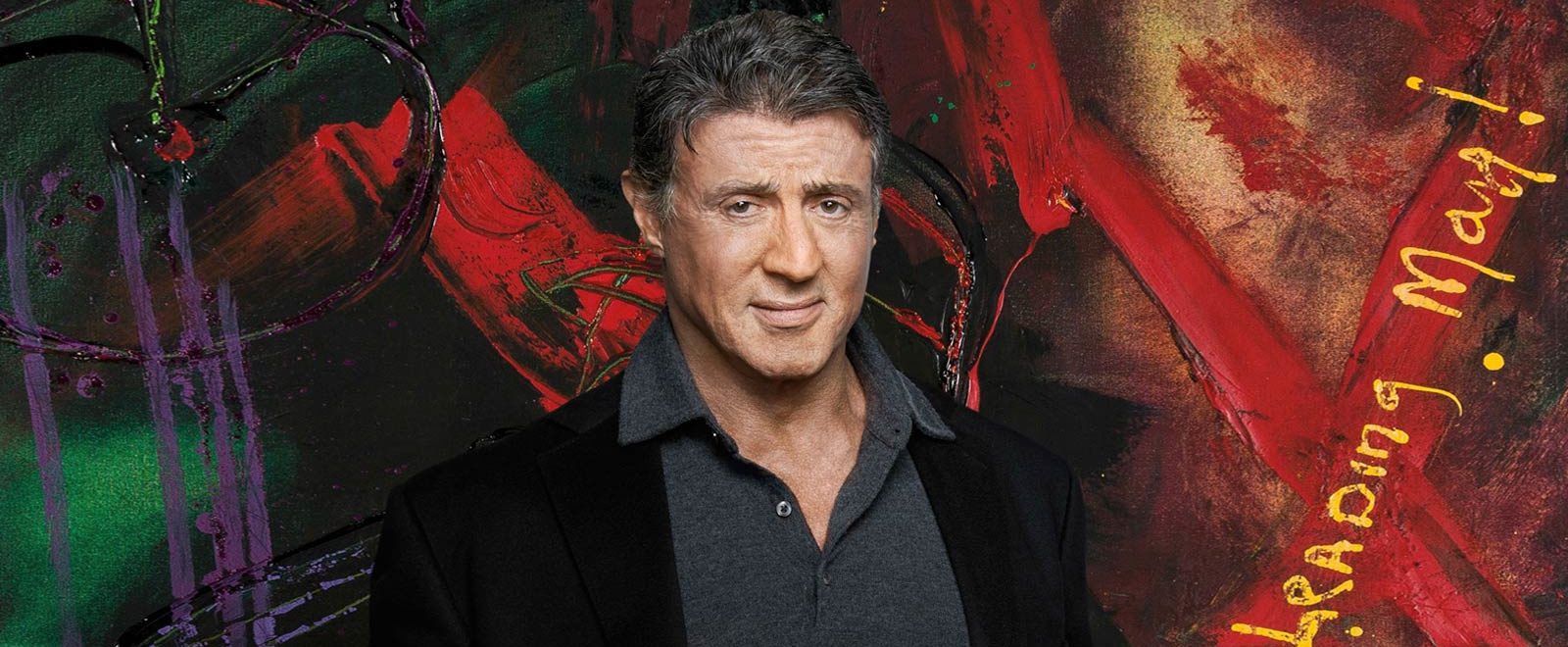WITH ‘ROCKY’ AND ‘RAMBO’ SECURELY POSITIONED IN AMERICA’S CULTURAL LEXICON, STALLONE DECIDES IT’S TIME TO SHARE HIS MEMORIES WITH THE WORLD
Interview by Hector Cantú
IN 2006, Rocky Balboa’s boxing robe and gloves joined Dorothy’s ruby slippers, Abraham Lincoln’s top hat and Dizzy Gillespie’s trumpet as important artifacts in the Smithsonian’s National Museum of American History.
Sylvester Stallone wore the red and yellow boxing robe in 1976’s Academy Award-winning film Rocky. He also donated his boxing gloves from Rocky II and his red, white and blue boxing shorts from Rocky III. “These objects could not be better in conveying the interplay of sports and entertainment in American film history,” Dwight Bowers, curator at the Smithsonian said at the time, “but more specifically, they could not better convey the importance of Sylvester Stallone to the film industry.”
Nearly 10 years later, Stallone is offering his personal belongings and movie memorabilia to the world. On Dec. 16-19, 2015, at the Hyatt Regency Century Plaza in Los Angeles, Heritage Auctions is hosting “Stallone – The Auction,” which includes more than 1,400 props, costumes and personal items consigned directly by the artist, writer, actor and director. “Sylvester Stallone is an international superstar,” says Heritage Auctions President Greg Rohan, “and these items include iconic, cultural symbols of clothing and props from his most famous and loved action films, the Rocky and Rambo series.”
EVENT
ENTERTAINMENT SIGNATURE® AUCTION 7111, featuring “Stallone – The Auction,” is scheduled for Dec. 18-20, 2015, at the Hyatt Regency Century Plaza, 2025 Avenue of the Stars, Los Angeles, and online at HA.com/Stallone. For information, contact Mike Gutierrez at 214-409-1183 or MikeG@HA.com, or Margaret Barrett at 214-409-1912 or MargaretB@HA.com.
Among the lots are the leather jacket Stallone wore as Rocky Balboa in the original Rocky; boxing gloves and Rocky’s “Eye of the Tiger” jacket from Rocky II; boxing trunks from Rocky’s fight against Clubber Lang (Mr. T) in Rocky III; Stallone’s screen-worn “Balboa” boxing robe from Rocky IV; and the U.S. Army flag-patch jacket Stallone wore in the first Rambo movie.
While auctioning his memorabilia proved a difficult decision, Stallone says visiting his warehouse and pulling items for the auction was an emotional rollercoaster.
“A lot of things!” he says when asked which items have sentimental value. “The Rambo knives. The Rocky II gloves. Incredible. The boxing trunks with Rocky’s blood on ’em.”
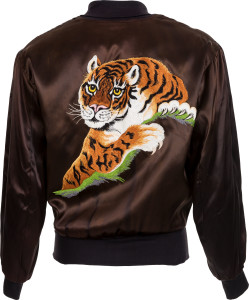
Rocky II
United Artists, 1979
One particular piece that proved hard to part with was the clothing he wore during his training scenes in 2006’s Rocky Balboa (also known as Rocky VI), the sixth installment in the Rocky franchise that features what Stallone says is Rocky’s final fight.
“The sweat suit, sweatpants, hood, even the underclothes, the sweatshirt under the long underwear, the shoes, the hand wraps … the scene when he’s standing on the stairs and it’s snowing,” Stallone says. “That is the last moment of the real Rocky Balboa story. It doesn’t go any further than that. That is the end. That clothing was soaked and I was freezing, but it’s the last thing I ever wore as Rocky, per se. So I put it all in a bag, literally took it off and didn’t open it for, well, seven, eight years and now it’s in the auction.”
Let’s talk about your artwork. You have a piece in the auction titled “Never Up By Noon, Leading Man” that was done in 1990. What’s the story behind that painting?
I did a series on, what I recall, my impression of early Hollywood and how the decadence and the lifestyle eventually kind of erodes our disciplines and the way we were raised, and we start to develop new habits, which are kind of, let me see, detrimental and debilitating. So you’re out all night and you’re never up by noon and it’s just a way of saying how you’re kind of going down the slippery slope to self-destructiveness.
So by this time, in 1990, how long had you been painting?
My first painting was done in 1957, so I’ve been painting for quite a while, drawing at least.
I was speaking to someone in Hollywood recently and he has a piece you did for charity and he tells me he gets calls from people who want to buy it. That’s probably nice to hear.
I just had two very successful showings in Europe, especially the last one at the Museum of Modern and Contemporary Art in Nice.
Describe the fulfillment you get when you see your art on exhibit. How’s that different from movies?
Art painting is probably one of the purest ways of interpreting what is truly on your mind or in your soul. It doesn’t have to have the precise clarity of the written word. It’s more or less free-flowing. It’s so different from movies because you need 500 people, 400 people to complete a film. So it’s never your vision. It’s many people’s visions. Art is truly a window into a person’s psyche.
So what’s the difference between standing in front of your art and standing in front of one of your movie posters?
One is as though you’re looking at a manufactured, maybe superficial character that is non-existent, that you are basically hired to interpret or play. In other words, when you look at a poster, you are looking at something that is created for the commercial environment to make money and reach a wide audience. Art is a very singular expression and something that speaks only to you, whereas in films, you must speak to, hopefully, millions of people. But in art, that’s not necessarily the case. Even if you reach a few, that’s successful to an artist. It’s not meant to be a movie, a smash hit.
It’s two completely different forms of satisfaction.
Oh, yeah. It’s not even in the same universe.
I see there are some racecar items in the auction. When did you first become interested in racing?
1998. 1997. I wanted to do a film about the world of open-wheel racing, so I spent a lot of time overseas with some of the greats. Damon Hill. Michael Schumacher. Ayrton Senna. People like that. And that’s when I wrote the screenplay for [the 2001 action drama film] Driven. It was primarily set in Formula One, but it ended up being an American film. That’s when I started, when I became engrossed in it.
What was the spark that got you there?
There are two things that I believe man inherently does. One is everything in one way or another is a fight, be it cerebral or physical. And everyone is also racing against something, either time, their opponent, a deadline, you’ve got to pay your taxes, you’ve got to get up early, you’re late for this, you’re late for that, you’re early for this, you’re early for that. So time and fighting are two things that just seem part – an indelible part, an inextricable part – of the human psyche on every level.
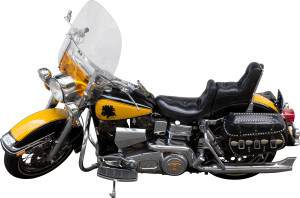
Rocky III
United Artists, 1982
Rocky V
MGM, 1990
Tell me about your relationship with Ayrton Senna. I understand one of his helmets is in your auction.
I was speaking with him about doing a movie about him, and he was very, very, very kind. We spoke quite a lot on the phone, and then he sent the helmet, and then he passed away [in a 1994 racecar accident]. I went, “Oh, God.” So I just couldn’t bring myself to do it. That’s not the movie I wanted to make. I wanted to make something that was kind of life-affirming and this was too sad.
You have in the auction the Harley Davidson motorcycle you rode in Rocky III and Rocky V. Why’s that a favorite of yours?
I’ve driven it for many, many miles and then I had to patch it up and get it working again and restore it to its original glory. The bike itself is very symbolic in Rocky III because of the emblem on it and it shows Rocky in all of his glory. And then it also shows him in his most depressed state, when he drives it up to the top of the steps, which I thought is really a pretty symbolic look. So we see the motorcycle at the top of the steps and then he’s attacking the statue while sitting on his motorcycle. … That’s the real one I did it with. There were two other bikes, but this is the authentic one that I rode, along with the helmet I threw. There’s only one that exists in the world.
And that helmet you threw in the movie is in the auction, too?
Yeah.
I just read a story that polo is a family sport. You have some polo items in the auction?
Oh, yeah. I played in the World Cup matches. I was very serious in polo. My father was in the cavalry during the war, on the Mexico border. Go figure. So I was involved with horses my whole life. “Stallone” means horse, and I just started playing polo and I became addicted to it, and I played all over the world. At one time, that’s all I wanted to do, was breed polo ponies. So I had the best equipment made and those boots. Is that what you’re referring to?
I was referring to a leather saddle with your name on it.
That’s a western saddle. The polo boots were used actually in the games, and the saddle itself was made by [J.M.] Capriola. The fellow’s died now. He was a very famous Italian saddle-maker. He was based in America and he custom-made that for me, and I used that for trail-riding to unwind after polo games.
I also see in the auction the golden glove pendant that Mickey gives to Rocky in Rocky V.
I was doing a show called The Michael Douglas Show and Joey Bishop was on the show. He was the comedian involved in the Rat Pack. And he goes, “You know, I really loved Rocky and you were very nice to Rocky Marciano and I have something that he gave me, but I think he’d want me to pass them on to you.” So he gave me these gold cufflinks that Rocky Marciano gave to him. And I went, “This is extraordinary.” And that’s why I put that in the movie, so when he [Mickey] goes, “This is my favorite thing, from Marciano,” it’s true what Mickey is saying to Rocky. And then I wear it in the film.
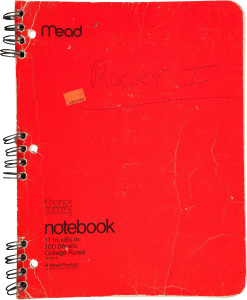
with Handwritten Scene Drafts
and Script Notes
Rocky
United Artists, 1977
There’s also a handwritten notebook you kept on the set of Rocky.
Oh, yeah.
What were you writing down? Notes on the movie? Personal writings?
A lot of [the writings] are ideas. As we’re filming, I’d be writing scenes, rewriting scenes and those are, like, that was the first, I think, 20 pages of Rocky I, how it started. … So that’s the actual writing of the first few scenes of Rocky I, when I meet [Rocky Balboa’s best friend] Paulie in a bar and ask him about his sister.
So these are, in your handwriting, your revisions for the script?
Yeah, it’s the actual writing. That’s the real deal. I’d jot down thoughts. But inside it’s about 25 pages [of script drafts and notes]. I don’t know where the rest [of the original script] is, but that’s the only thing I can find.

Rocky
United Artists, 1977
The auction includes some items from the Judge Dredd movie, which was based on a comic book. Are you a comic book fan or are these properties that popped up and just happen to be based on comic books?
No, no, no, no! My whole thing was the Flash and Plastic Man. I liked those bizarre kind of characters. I wasn’t so into Superman. Batman more. And then I got into, of course, the Hulk, the Marvel comics. Yeah, very much so. Very, very much so. But I read all comics, even going back to Classics Illustrated, where they reinterpreted the great literature. I’ve had them all. But Judge Dredd, I thought, had the potential. It never quite came off for various reasons, but this to me was an amazing character.
Do you still buy comics?
Not so much anymore. I try to spend my time painting now and writing.
Why are you selling now? What’s the spark that led to this auction?
What am I keeping it for, really? My children certainly have some choice pieces, but I thought at my age I’d like to see it go while I’m alive and know where it goes and have some supervision over it, rather than wait until I’m dead and then someone else picks over my belongings. It’s kind of, I don’t know, invasive. I’ve always seen people wait until they’re dead and I never understood that. Then I see that Elton John does it [auctions personal items] or Barbra Streisand does it, and maybe that’s pretty smart to do.
I’ve had so many different pieces in storage and I think, you know, it’s funny, I haven’t been in this place in 15 years, so what are you hoarding? What are you doing? It’s not as though you can’t live without these pieces, but other people would really appreciate them. So rather than keep them in the dark and just forget about them, I thought, “Let me just pass it on.” I thought, you know, I’ve already put Rocky memorabilia in the Smithsonian museum and a few other incredible places, so I’ve sort of accomplished my goal in that way of making sure the Rocky legacy is really well-protected. And now, you know, give back and see if people really want it.
I’ve never understood why people just keep storing things and then they pass away, and it’s “What were they planning to do with all those things?”
What’s the perfect home for these items? Where do you hope they end up?
Oh, I guess people, real fans who buy these things on an emotional level, that’s where they should go. I remember, and it’s like the Rocky Marciano gloves, when someone like Joey Bishop said “I want you to have these because you’ll appreciate them more than I will now. You’ll really love them.” I’ve taken all the love I can out of them. I’ve used them and it’s been wonderful. But, for example, Rambo’s knives or his forging tools … that’s a nice moment in my life, but I think it could be really something in someone else’s house. They would hold that in a very special place in their heart, because the movie touched them, whereas it’s already in my heart, you know what I mean? Those memories are there.
Why did you select Heritage Auctions?
Because of the John Wayne situation [Heritage Auctions hosted the Personal Property of John Wayne Auction in October 2011]. And I spoke with other places and I found that they [Heritage] had an authenticity to them and I really believed they’ve dealt with this before, and they are so incredible with their auctions, especially coins. So I thought yes. And their database is so big!
Are you a collector? Do you collect anything?
I collect art. I collect artistic knives. I have some up for auction. I try to find real artisans from around the world, not just knives but metal workers, because they are almost the same as sculptors. They’re incredible.
Some of the proceeds from your auction will be donated to charities and organizations that assist veterans and wounded U.S. servicemen and servicewomen. Why is that important to you?
These fellows are so underappreciated for what they do and the sacrifices they make. It’s seems as though when they come back, they should be guaranteed a house, guaranteed a job, guaranteed medical attention. For a military man to be homeless is just unconscionable. It’s unbelievable to me. Having played military characters, I just feel there’s a natural bond there, and I’m going to try and do something nice for them.
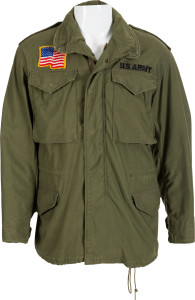
First Blood
Orion, 1982
Starting bid: $7,500
HECTOR CANTÚ is editor of The Intelligent Collector magazine.

